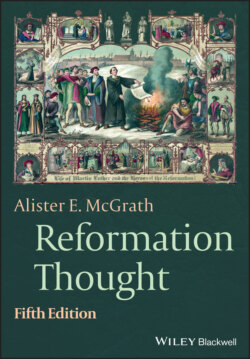Читать книгу Reformation Thought - Alister E. McGrath - Страница 35
For Further Reading
Оглавление1 Bagchi, David V. N. Luther’s Earliest Opponents: Catholic Controversialists, 1518–25. 2nd ed. Minneapolis, MN: Fortress Press, 2009.
2 Bailey, Michael. “The Disenchantment of Magic: Spells, Charms, and Superstition in Early European Witchcraft Literature.” American Historical Review 111 (2006): 383–404.
3 Barbier, Frédéric. Gutenberg’s Europe: The Book and the Invention of Western Modernity. Malden, MA: Polity Press, 2016.
4 Bernard, George W. The Late Medieval English Church: Vitality and Vulnerability before the Break with Rome. New Haven, CT: Yale University Press, 2012.
5 Biow, Douglas. On the Importance of Being an Individual in Renaissance Italy: Men, Their Professions, and Their Beards. Philadelphia, PA: University of Pennsylvania Press, 2015.
6 Bynum, Caroline Walker. Christian Materiality: An Essay on Religion in Late Medieval Europe. New York, NY: Zone Books, 2015.
7 Christman, Robert J. Doctrinal Controversy and Lay Religiosity in Late Reformation Germany. Leiden: Brill, 2012.
8 Close, Christopher W. The Negotiated Reformation: Imperial Cities and the Politics of Urban Reform, 1525–1550. Cambridge: Cambridge University Press, 2009.
9 Cohen, Walter. “The Rise of the Written Vernacular: Europe and Eurasia.” PMLA 126, no. 3 (2011): 719–29.
10 Copenhaver, Brian. Magic in Western Culture: From Antiquity to the Enlightenment. Cambridge: Cambridge University Press, 2015.
11 Delumeau, Jean. Catholicism between Luther and Voltaire. London: Burns & Oates, 1977.
12 Duffy, Eamon. The Stripping of the Altars: Traditional Religion in England c. 1400–c. 1580. New Haven, CT: Yale University Press, 1992.
13 Duffy, Eamon. The Voices of Morebath: Reformation and Rebellion in an English Village. New Haven, CT: Yale University Press, 2001.
14 Edwards, Mark U. Printing, Propaganda and Martin Luther. Minneapolis, MN: Fortress Press, 2005.
15 Hillman, Jennifer. Female Piety and the Catholic Reformation in France. London: Routledge, 2015.
16 Hornbeck, J. Patrick, ed. A Companion to Lollardy. Leiden: Brill, 2016.
17 Johnson, Ian. The Middle English Life of Christ: Academic Discourse, Translation, and Vernacular Theology. Turnhout: Brepols Publishers, 2013 .
18 Katajala-Peltomaa, Sari. Lived Religion and the Long Reformation in Northern Europe c. 1300–1700. Leiden: Brill, 2017.
19 Klaassen, Frank F. The Transformations of Magic: Illicit Learned Magic in the Later Middle Ages and Renaissance. University Park, PA: Pennsylvania State University Press, 2013.
20 Lambert, Malcolm. Medieval Heresy: Popular Movements from the Gregorian Reform to the Reformation. 3rd ed. Oxford: Blackwell, 2002.
21 Laursen, John Christian, Cary J. Nederman, and Ian Hunter. Heresy in Transition: Transforming Ideas of Heresy in Medieval and Early Modern Europe. London: Routledge, 2016.
22 Lutton, Robert. Lollardy and Orthodox Religion in Pre-Reformation England: Reconstructing Piety. Woodbridge, ON: Royal Historical Society in association with the Boydell Press, 2011.
23 Marshall, Peter H. The Magic Circle of Rudolf II: Alchemy and Astrology in Renaissance Prague. New York, NY: Walker & Company, 2006.
24 Martin, John Jeffries. “Inventing Sincerity, Refashioning Prudence: The Discovery of the Individual in Renaissance Europe.” American Historical Review 102 (1997): 1309–42.
25 Martin, John Jeffries. Myths of Renaissance Individualism. New York, NY: Palgrave Macmillan, 2004.
26 McGrath, Alister E. The Intellectual Origins of the European Reformation. 2nd ed. Oxford: Blackwell, 2003.
27 McSheffrey, Shannon. “Heresy, Orthodoxy and English Vernacular Religion 1480–1525.” Past and Present 186 (2005): 47–80.
28 Muldoon, James. Bridging the Medieval-Modern Divide: Medieval Themes in the World of the Reformation. London: Routledge, 2016.
29 Olszewski, Mikołaj, ed. What Is ‘Theology’ in the Middle Ages? Münster: Aschendorff, 2007.
30 Page, Sophie. ‘Medieval Magic,’ in The Oxford Illustrated History of Witchcraft and Magic, edited by Owen Davies, 29–64. Oxford: Oxford University Press, 2017.
31 Peters, Christine. Patterns of Piety: Women, Gender and Religion in Late Medieval and Reformation England. Cambridge: Cambridge University Press, 2008.
32 Pettegree, Andrew. The Book in the Renaissance. New Haven, CT: Yale University Press, 2010.
33 Rubin, Jared. “Printing and Protestants: An Empirical Test of the Role of Printing in the Reformation.” Review of Economics and Statistics 96, no. 2 (2014): 270–86.
34 Russell, Alexander. Conciliarism and Heresy in Fifteenth-Century England: Collective Authority in the Age of the General Councils. Cambridge: Cambridge University Press, 2017.
35 Russell, Camilla. “Religious Reforming Currents in Sixteenth-Century Italy: The Spirituali and the Tridentine Debates over Church Reform.” Journal of Religious History 38 (2014): 437–75.
36 Scase, Wendy. Piers Plowman and the New Anticlericalism. Cambridge: Cambridge University Press, 2007.
37 Serina, Richard J. Nicholas of Cusa’s Brixen Sermons and Late Medieval Church Reform. Leiden: Brill, 2016.
38 Tanner, Norman P. The Ages of Faith: Popular Religion in Late Medieval England and Western Europe. New York, NY: Palgrave Macmillan, 2009.
39 van den Berg, Michiel A. Friends of Calvin. Grand Rapids, MI: Eerdmans, 2009.
40 Watkins, Carl. “‘Folklore’ and ‘Popular Religion’ in Britain During the Middle Ages.” Folklore 115, no. 2 (2004): 140–50.
41 Zambelli, Paola. White Magic, Black Magic in the European Renaissance: From Ficino, Pico, Della Porta to Trithemius, Agrippa, Bruno. Boston, MA: Brill, 2007.
